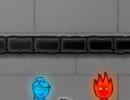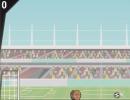Carpet embroidery and creative needlework. Carpet embroidery using a special needle Carpet embroidery with a needle
Homemade carpets are not only original and beautiful, but also very interesting and exciting.
For those who like to do things with their own hands, we will give a small guide
First you need to decide what size carpet you need and what to use as a basis. The easiest way is to stuff a carpet onto an old bedspread with a pattern you like, discarding the extra details of the pattern. I chose another option - I drew fragments of the future pattern on paper.
If you don’t know how to draw, patterns can be copied from any bedspreads and even from tulle. Use plastic wrap for this. Laying it on top of the bedspread (or paper with a pattern), draw the pattern ballpoint pen. Then take a larger film and, placing your fragments under it, make a pattern for one corner of the carpet. In the same way, you can create an ornament for the middle and border of the carpet on separate films.
Now you need to prepare the fabric onto which you will transfer the entire carpet pattern. To do this, you can use an old sheet (or, for example, sew several diapers, but so that you don’t get thick seams). Lay the fabric on the floor and, placing carbon paper under the film, carefully transfer the design onto the fabric. The good thing about the film is that if it accidentally moves, it is easy to put it back in place. After the pattern is transferred to the fabric, sew it onto an old, worn-out bedspread. The base of the carpet is ready.

It is better to make the stuffing device (Fig. 1) yourself. It consists of a handle, a needle and an adjustment screw. The handle can be made of wood, metal or ebonite. Drill a hole inside it, also install an adjusting screw (with its help you can change the length of the needle, and therefore the length of the pile).
The needle (Fig. 1a) can be used from droppers; only in the center of the tip, using an awl and a hammer, make a hole as large as possible in diameter so that the working thread can pass through it freely. Using needle felters, carefully smooth out all the rough edges around and inside the hole, sharpen and polish the edges of the needle so that it does not cut the fabric when piercing.
Another important point: To prevent the finished needle from breaking, it must be hardened. Holding the needle with pliers, heat it over the fire and sharply lower it into cold water.
Now you can assemble the device. The fabric must be stretched before stuffing. Some people make special machines for this, but I use ordinary boiling. It is also convenient because after finishing work you can put away balls of thread, a needle, and an elastic band. I secure the carpet to the strip with 5 m of elastic so that the sheet with the pattern is on top (Fig. 2). I thread the thread into the device from the handle side, pass it through the needle and out through the hole in the needle. During operation, the thread should come out of the needle freely. If it clings and pulls back behind the needle, you need to choose a thread of a different thickness. According to the applied pattern, I sequentially pierce the fabric with a needle until it stops with the same step of 3-5 mm. When removing the needle, I try to ensure that it does not come off the fabric, but slides along it to the place of the next injection, otherwise the loops on the front side will be uneven (Fig. 3). To make the drawing clearer, you can run 2 rows of black thread along the contour of each flower and leaf.
When the entire fabric of the carpet has already been knocked out, I sew a clothesline along the edge, tucking the edges of the sheet and bedspread under it. After this, I tightly stitch the edges with a looped seam using an ordinary needle.
The pile on the carpet can be left in the form of loops, or you can cut them to the desired height. In order not to unravel the carpet by accidentally pulling a loop, you need to apply a thin layer of PVA glue to the back side of it and dry it well.
I practically didn’t buy threads for my carpets - I unraveled old knitted items. And so that the thread was straight, I wound it around a glass bottle, dipped it in hot water, after which I left it to dry in this position. If the thread broke, I tied the ends with knots, and then simply cut the knots off the carpet. It happens that the nodules do not fit into the eye of the needle. In this case, you can alternately tie thread for work and bobbin thread for sewing. The knots will be thinner and fit well into the eye, and the thread will not have to be threaded over and over again. When the working thread runs out, pull the spool thread. A working thread has appeared in the needle hole, cut off the bobbin thread, etc. It’s troublesome, but even scraps of thread are useful.
In the same way, you can make rugs for the bathroom and toilet (or a set - a rug for the floor and a cover for the toilet lid). Beautiful one-color rugs are obtained if you make a pattern on them using the pile different lengths. The finishing stripes (Fig. 4) can be made with a small pile in several rows, and the center - long.
A very fluffy bedside rug is made from polyester thread using a different technique (Fig. 5). The working tool is a tube (preferably metal) 10-15 cm long, through which a thread is passed. It is very important that the thread does not catch and slides freely in the tube. The end of the thread is melted a little over a candle and quickly pressed against the fabric. The thread is “glued”. Lifting the tube, cut off the required length of pile with scissors.
In both ways, you can make not only carpets, but also wall panels, sofa cushions - in general, everything that your imagination tells you.
Valentina Yakimovets
Based on materials from the newspaper "Toloka. We do it ourselves"
Embroidery using carpet technique has its own characteristics, since it is not at all similar to other types of embroidery. Finished goods They are distinguished by their softness and similarity to a real carpet. Used to create pillows, blankets, paintings, bedspreads, toys. Today we will look at carpet needle embroidery and describe the methods and technology for creating the work.
Embroidery Features
The embroidery in question has several varieties and methods.
- Embroidery and coloring books. Embroidery involves attaching short threads to a mesh base.
- The next type differs in that a special hook is used in the work. The main difference from other types is that you can embroider with a needle and crochet. Embroidery is characterized by fastening the threads on the front side, which creates a fleecy pattern. The basis for embroidery can be mesh or burlap. It is often used to create paintings and panels or small rugs with a simple pattern.
- Making tapestries. It is widely believed that creating tapestry paintings is very difficult process. We hasten to please our needlewomen, this technique is comparable in complexity to ordinary cross stitch. Truth in technology tapestry embroidery has its own characteristics.

The work uses a special needle. We can say that this is a tube whose ear has a bevel. Thanks to the presence of a special lock on the needle, the loops of thread are the same length and thereby form a uniform pattern. Like any type of embroidery, this kind of embroidery is quite a painstaking task.
It is worth remembering that during the embroidery process the needle must pierce the fabric, so for convenience it is recommended to use a frame or fingers.
The work must be done on a tight basis. It can be used as a grid, the cells of which are not too large. You can use a base made of thread.
Pick up the necessary diagram Quite simple to work with. You can search on the Internet or go to a store. In the latter you can purchase a kit that contains everything you need for work. But you can draw the diagrams yourself, transfer them to the embroidery base and fill them with colored threads to your liking.

Embroidering correctly
For embroidery, it is possible to use leftover yarn or thread that the needlewoman has left over from other projects.
The work is done on the wrong side of the base, and on the front you will get loops with pile. Therefore, to facilitate the process, it is recommended to make color markings before starting work.
The base must be very well secured and tensioned, since when piercing with a needle, the tightness of the tension is important.

The embroidery process must begin by “drawing” the outline of the image. Then you can fill in the space in the outline, do small details and you can start filling in the background. When working, hold the needle with the beveled edge up.
The seams in this technique are quite simple, their execution is accessible even to novice craftsmen. Each detail of the drawing is performed separately; it must be filled in moving from the edge to the middle.
To simplify the embroidery process, you need to move from right to left when working, and keep the needle in a vertical position. This will help prevent the needle from damaging the loops and pulling them out. If done correctly and carefully, the pile will not need to be leveled.

Carpet painting
Here is a master class on tapestry embroidery. The process of creating such a painting is distinguished by the presence of a much larger number of colors in the work.
Most often the tapestry has big size, so it’s better to use frames in your work. It is recommended to wash the base before work and only then insert it into the frame to prevent the fabric from sagging.

After this, the design must be transferred to the fabric. In order not to confuse the threads when working, you need to make markings on the base indicating the thread number.
The stitches need to be done as tightly as possible to avoid gaps. To make the loops beautiful, the thread must be loose when embroidering. Length - approximately 2 meters.
When changing the color of the threads, the thread with the same color must be taken out on the wrong side and cut, and the new color must be threaded into the needle.
Periodically you need to check the pile on the front side; if individual fibers are too long, they can be corrected with tweezers, and if they are short, they need to be slightly tightened.

To prevent the finished work from unraveling, the seams must be secured. To do this, you need to treat the seams on the reverse side with simple office glue. The glue should be liquid, this will facilitate the processing process and the base will remain soft and can be bent. Let dry thoroughly. Then you need to iron it from the inside out.
All that remains is to trim the fibers on the front side with scissors and our tapestry is ready.

Video on the topic of the article
We invite you to watch several videos on carpet embroidery.
Unusual handicraft – carpet embroidery technique. One of the most beautiful and easiest embroidery techniques is experiencing a rebirth today. Carpet weaving is popular due to the fashion for exclusive items self made. Even a beginner in needlework can learn to embroider with this technique; you just need to be patient.
This technique has an amazing history; it began a long time ago. Today this embroidery method is in demand in interior decoration, because the name speaks for itself: panels, tapestries, rugs. All this is often used in the interior.
In addition, the technique is used in creating special fashion accessories– original bags and even toys. Famous couturiers never forget about it, using it in unusual decoration. Meanwhile, the technique is so simple and interesting that even children can learn it after the first lesson.
You need to start with the basics, namely from ready-made sets for newbies. They include a canvas with a created pattern, plain threads, a hook and a needle.
The main thing is the basis; in this technique, to obtain a good result, they use special processed rigid canvas. This is very important if you want to make an interior item - a tapestry, rug or bedspread.
The result also looks great on dense double-thread fabrics, which perfectly keep the shape of the finished item. Can also be used fillet mesh with cells the right size if you want to make soft, flexible embroidery, for example, to decorate a simple pillow.
Besides this, you will need hoop or frame, on which you will have to pull the base. There is no need to neglect them, especially at the beginning of mastering the technique, because they allow you to make uniform and dense stitches.
The stitches turn out well even if your hand is not full, and it also helps to select color combinations threads Beginners should choose a design that is ready-made or applied to the product themselves, with clear contours and large details.
 If you want to embroider a tapestry or rug for a nursery with a funny “cat” portrait, do not try to make mustaches, stripes and other small graphic shapes. Even a sketchy rug with clear contours will surprise and delight you with the result, and you will get the experience you need.
If you want to embroider a tapestry or rug for a nursery with a funny “cat” portrait, do not try to make mustaches, stripes and other small graphic shapes. Even a sketchy rug with clear contours will surprise and delight you with the result, and you will get the experience you need.
In carpet weaving, voluminous, thick pure wool or mixed threads, are still good for this acrylic and light and brightly colored. When choosing a material, it is necessary to take into account that acrylic is easy to care for, but wool looks nobler and more interesting.
It’s not for nothing that knitters love this embroidery method; it helps to create unusual and sometimes unique things from practically nothing. Often the worst balls and skeins are used, and sometimes even threads that should have been thrown away long ago.
Basic tools you will need for work:
- needles;
- special hooks.
So we have figured out the tools for carpet embroidery for beginners.




Gallery: carpet embroidery technique (25 photos)



























Carpet embroidery with a needle, loop embroidery, diagram and video lessons for free
How to embroider a carpet? To perform embroidery, you will need special needles; they help you work with a single thread, making a pattern of voluminous interesting loops on the front side of the item. You only need two needles for the job:
- For thin threads;
- for thick threads.
 Needles can be purchased at sewing and craft stores. The principle of their operation, regardless of the brand, is as follows: the thread passes through the entire needle with an “eye” at the sharpened end, and the fixing part makes it possible to create uniform “stitches” of the same size on the base without much effort.
Needles can be purchased at sewing and craft stores. The principle of their operation, regardless of the brand, is as follows: the thread passes through the entire needle with an “eye” at the sharpened end, and the fixing part makes it possible to create uniform “stitches” of the same size on the base without much effort.
The first thing you need to do is create sketch. It could be like finished drawing, and your own. The main thing is that it has the correct shape and well-made contours. It is worth remembering that the design is applied inside out, i.e. in a mirror image. Samu the base needs to be pulled well onto the frame, because the needle can greatly pierce the fabric during operation. Any stitch in needle embroidery is a simple movement; the needle must be inserted into the base all the way and pulled back. On the front side you get a looped embroidery fabric.
Each loop is made with a simple precise movement of the needle: from the inside to the front side. Stepping back a little from the previous puncture, a new loop is made. The frequency of stitches depends on how dense and voluminous you want to make your embroidery. You must not raise the needle too high and do not tighten the thread, leaving it loose, because otherwise the embroidery loops may begin to unravel.
Carpet embroidery using a crochet hook
No less beautiful shape and the design can be made using a crochet hook. For such purposes, you can take a simple crochet hook. Real craftsmen use a special hook with a movable lock, which helps them embroider more beautifully and efficiently.
Unlike the needle technique, the threads for working with a hook need to be cut into equal segments with a length of no more than five centimeters. To get this size, the threads can be wound on a simple school ruler, and then everything will turn out perfect. You need to throw a folded piece of thread onto the hook threaded into the canvas, close the hook lock and pull it out from the front side of the canvas.
Creating something new is always interesting for any needlewoman, and if it is also beautiful, it is generally attractive. One such activity is carpet embroidery. Although this is not the new kind creativity, but for a certain time it was forgotten, so not many people know about it. Now this type of creativity is being resumed, tools for it are appearing in stores, so there is a need to conduct a master class and explain in detail what carpet technology is, this will be especially relevant for beginners.
It can be used on almost any product, for pillows, for panels, for throws, even for carpets.
We study the basics of carpet technology for beginning craftsmen
For those who are completely unfamiliar with the technique of carpet embroidery, we will tell you a little about its features.
Carpet embroidery comes in two types: looped and knotted. They differ in the way the pile covering is made. Loop embroidery is obtained by using a special needle on thick fabric, and knotted - when using a special hook on a vinyl or special base.
A needle for carpet embroidery is a tube with a beveled corner and an eye at the tip. In addition, it has a handle-shaped lock, which allows you to make loops of the same size, because the result depends on this. To work, you also need to have a hoop or a special frame to secure the fabric.
The hook is distinguished by the fact that it is equipped with a small lock, which allows you to quickly pull out the thread and tighten the knot. Therefore, the fabric is not suitable for such work; you need a special canvas with holes or at least a construction mesh.
Due to the specificity of the tools for such work, carpet techniques are considered difficult to perform. But, in fact, when using the tool correctly, embroidering with it is no more difficult than cross-stitching.
The result is fluffy, voluminous and very beautiful products.
The peculiarity of carpet technology is the need for special tools and material.
Materials and tools:- Hook for carpet embroidery
- Canvas - Stramin or construction mesh
- Threads of different colors
Before starting work, you need to prepare the threads; you won’t be able to use them in a ball; they need to be cut into equal lengths. This, unfortunately, is not very convenient, which is a slight disadvantage compared to using a needle.
To do this, take a thick piece of cardboard, cut a strip 2.5 cm wide and wrap a thread around it in a circle. Then we cut it on one side, we get identical pieces 5 cm long - exactly what we need. Keep in mind that if you have thin threads, you will need to use two or three threads per knot, otherwise the work will be loose, with gaps and completely ugly.
Now let's start embroidering step by step.
You need to start working from the bottom right edge (unless you are left-handed). The figure shows a diagram of how to use a hook and loop, which is obtained when embroidering.

We fold the piece of thread exactly in half, this determines how smooth the fluffy surface will be. We put it on the hook, close it and pull it through the canvas to the front side. It turns out that tails of threads remain on the front side, and a tight knot on the back side.

This method of embroidery, unlike needle embroidery, allows you to observe the front side of the embroidery immediately and evaluate the quality of the work. This way it is also easier to create blurry transitions from one shade to another. The result is a very realistic picture.
Another advantage of crocheting is that you don’t need to trim the edges, just fold the edge so that the holes match and knit it through two layers.

When the work is ready, you will need to secure the threads on the wrong side. To do this, dilute PVA glue with water in a ratio of 2:1 and very carefully apply the solution to the inside with a brush. It is important to do this so that the mixture does not flow onto the front side and spoil the work. Cover the surface with polyethylene and let it dry for at least a day. After removing the bag after drying, you can see a very smooth surface. You can glue non-woven fabric onto it to finally secure the result. Now we can confidently use the resulting creation for its intended purpose.
Products with carpet embroidery in finished form they look very impressive and, as they say, rich, so they can be an excellent gift for a housewarming or other occasion. Moreover, this does not depend on what kind of tools they are made with: using a hook or a needle. So learn, develop, create, and give people joy in the form of various handmade creations.
Video on the topic of the article
Below is a selection of videos with which you can watch the process of embroidery using carpet techniques.




At home, decorative products are made, the surface of which resembles carpet. This effect can be achieved different ways. One of them, the simplest, is to make loop stitches using a special device.

It consists of a thin tube or medical needle, at the sawn end of which there is a hole for the passage of threads, and a handle with or without a needle length regulator.
The loop stitch technique can be used to make rugs, tapestries, chair covers, sofa cushions, etc.

MATERIALS TOOLS AND DEVICES
NEEDLE
FRAME or Hoop
THREAD AND YARN
THREADTHREADER
TEXTILE

The needle can be purchased at the store. But this needle will quickly break, because... attached to a plastic handle. It is better to order several needles of different lengths and thicknesses with a wooden handle from the workshop. Most often, 4 types of needles are used to work on a tapestry.

FRAME or Hoop
This is a wooden or metal frame onto which the material is stretched. For convenience, it is better to take a larger frame than the intended work.

Threads and yarn
Almost any color-resistant thread is suitable for non-woven tapestry. Exceptions are boucle threads or yarns, as well as threads with a weak twist, such as roving. Each type of thread: wool, cotton, mixed, synthetic, artificial gives its own texture. Do not use threads thinner than #10, as they will curl and become tangled as you work.

Threader.
An ordinary thin long sewing needle, thin wire or fishing line can serve as a thread threader. A needle threader is used like this: insert a thread into the bend of the wire, insert the wire into a wooden handle, then through a needle into the hole at the tip of the needle. Then insert the needle into a metal insert to adjust the length of the needle and tighten the screw. The needle is installed so that the screw is located on the side in relation to the cut of the needle-tube.

A few commandments for the embroiderer
The embroidery pattern is applied to the wrong side of the fabric, as it is embroidered from the wrong side.

The stitch on the reverse side is similar to a machine stitch; loops are formed on the front side.

Thread the needle using a threader or sewing needle

See above for detailed drawing diagram of threading

To perform the covering, the fabric must be tightly stretched over the frame or hoop.

There are two ways to apply stitches to fabric: line stitches and outline stitches. Line stitching is the passage of thread through the fabric vertically up and down or from left to right, but always parallel to each other and to the grain or weft threads. Contour stitching involves placing a stitch along the outline of a design from the edges to the center.

The working thread should always be in a free position, without tension. Having made the first puncture on the fabric, you need to carefully remove the needle without lifting the needle above the fabric. The next puncture is made 2...3 mm from the previous one, etc.

The cut of the needle should always be in the direction of travel, i.e., turned towards the person working

When changing the stitch direction, the needle or hoop is turned. The stitches of the second row are laid in parallel, inserting the needle parallel to each other in the middle of the stitch of the previous row.

You cannot stick a needle into the same remaining holes, because the new loops will not be stable enough.

The pattern should be covered thickly, without gaps, so that the fabric does not show through the loops. But if the stitching is too thick, there is a danger that the stitch will fall into the holes of the previous row and push out the previously stitched loop.

If you have finished covering the design, and the thread is still quite long, it should be cut as follows: raise the needle above the fabric and cut the thread, leaving a tip of 1...1.5 cm. Experienced embroiderers determine by eye the required length of the thread before finishing the pattern and cut the thread above needle, gradually using up all the thread in the needle. There is no end left.
- CARPET NEEDLE
The needle can be purchased at
store. It is quite suitable for getting acquainted with the technique of non-woven tapestry.
But in the store the needle quickly breaks, because... attached to a plastic handle.
If you decide to seriously engage in this type of arts and crafts
art, it is better to order several needles of different lengths and thicknesses from the workshop
with wooden handle. Most often, 4 types are used to work on tapestry
needle:
A)
Main working needle -
length 3-5cm, with internal diameter –1.6-1.8mm. This needle is used for
cotton threads, such as “Iris”, “Tulip”, “Astra”, No. 10, in three
addition.
B)
Main working needle -
length 3-5cm, with internal diameter –2-2.5mm. This needle is used for
embroidery with synthetics and wool.
IN)
Auxiliary needle - length
–6-7cm, with an internal diameter of 1.8-2mm. Suitable for cotton threads
such as “Iris”, “Tulip”, “Astra”. No. 10, in three additions, but has more
long loop.
G)
Auxiliary needle – length 6-7 cm, with an internal diameter of 2-2.5 mm. It is applied for
embroidery synthetics and wool
Fabric base
For the base of a tapestry, linen is best suited.
Loose or loose weave is preferable. This condition is necessary for
so that the needle does not tear or pierce the material, but moves the fibers apart. At
the next puncture of the material must be clamped
working thread of the previous puncture. Otherwise, if you
work on cotton or wool material, the working thread will not
stick to the fabric. The ideal material for non-woven tapestry is
edging or harsh canvas. It is preferable to choose a dark fabric base
colors, because if you work on light material with dark threads, then
gaps between the loops will be visible and the fabric base will have to be painted with
wrong side. But if you work on a dark base with light threads, then
the gaps between the loops will not be visible.
What
do if...
If during operation the stitched
If the loop has just pulled out of the fabric, this means that either the thread of yarn is not loose enough
advances in the needle, or there are roughness in the hole of the needle (the eye of the needle is poorly polished). The situation can be corrected
as follows: pull the needle out of the fabric, pull the thread to the side
ball, leaving it for the length of one stitch, and again the needle is stuck into the fabric to
formation of a new loop.






